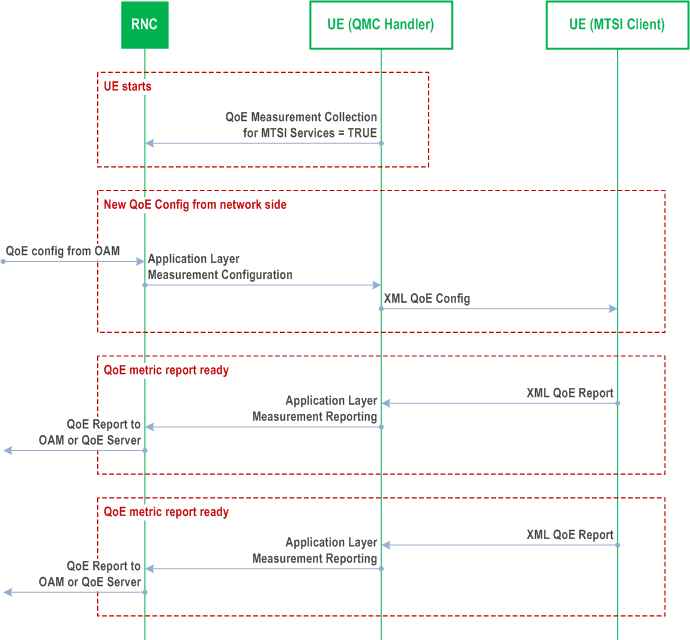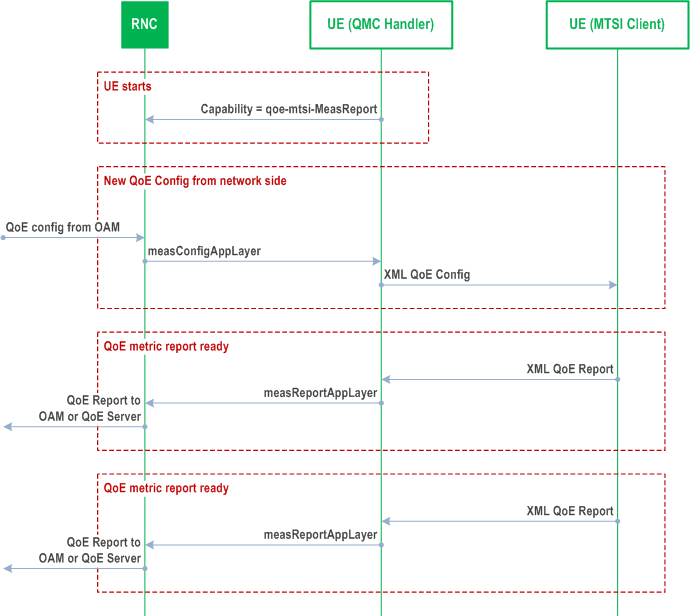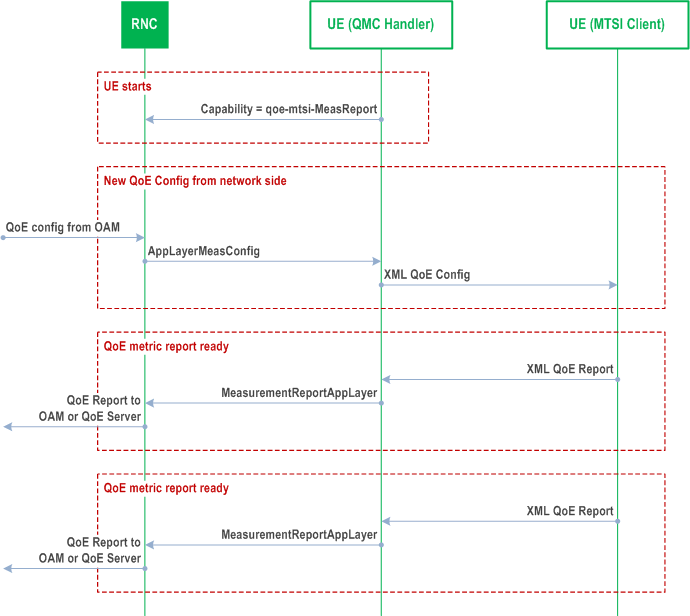Content for TS 26.114 Word version: 18.8.0
0…
3…
4…
5…
6…
6.2.3…
6.2.5…
6.2.7…
6.2.10…
7…
7.5…
8…
9…
10…
10.2.1.6…
10.2.2…
10.3…
10.4…
11…
12…
12.3…
12.7…
13a…
16…
16.5…
17…
18…
19…
A…
A.3…
A.4…
A.5…
A.10…
A.14…
A.15…
B…
C…
C.1.3…
C.1.3.5
C.2…
D
E…
E.18…
E.31…
G…
K…
L…
M…
N…
O…
P…
P.3
Q…
R…
S…
T…
U…
V…
W…
X…
Y…
Y.6…
Y.6.4…
Y.6.5…
Y.7…
16.5 QoE Measurement Collection Functionalities
16.5.1 Configuration and reporting
16.5.2 XML configuration
...
...
16.5 QoE Measurement Collection Functionalities |R15| p. 182
16.5.1 Configuration and reporting p. 182
As an alternative to configuration via OMA-DM, the QoE configuration can optionally be specified by the QoE Measurement Collection (QMC) functionality. In this case the QoE configuration is received via specific RRC (TS 25.331) messages for UMTS, RRC (TS 36.331) messages for LTE, and RRC (TS 38.331) messages for NR over the control plane, and the QoE reporting is also sent back via RRC messages over the control plane.
If QMC is supported, the UE shall support the following QMC functionalities:
- QoE Configuration: The QoE configuration will be delivered via RRC to the UE as a container according to "Application Layer Measurement Configuration" (see TS 25.331) for UMTS, "measConfigAppLayer" (see TS 36.331) for LTE and "AppLayerMeasConfig" for NR (see TS 38.331). The container is an octet string with gzip-encoded data (see RFC 1952) stored in network byte order. The maximum size of the container is 1000 bytes for UMTS (see TS 25.331) and LTE (see TS 36.331), and 8000 bytes for NR (see TS 38.331). When the container is uncompressed it is expected to conform to XML-formatted QoE configuration data according to clause 16.5.2 in the current specification. This uncompressed QoE Configuration shall be delivered to the MTSI client. The interface towards the RRC signalling is handled by the AT command +CAPPLEVMC for UMTS and LTE, and the AT command +CAPPLEVMCNR for NR, TS 27.007.
- QoE Metrics: QoE Metrics from the MTSI client shall be XML-formatted according to clause 16.4 in the current specification. The XML data shall be compressed with gzip (see RFC 1952) and stored in network byte order into an octet string container. The maximum size is 8000 bytes for UMTS (see TS 25.331) and LTE (see TS 36.331). For NR (see TS 38.331), the maximum size is 8000 bytes if RRC segmentation is not enabled, and 144000 bytes if enabled. The container shall be delivered via RRC to the RNC according to "Application Layer Measurement Reporting" (see TS 25.331) for UMTS, to the eNB according to "measReportAppLayer" (see TS 36.331) for LTE, and to the gNB according to "MeasurementReportAppLayer" for NR (see TS 38.331). The behaviour if the compressed data is larger than the maximum container size is unspecified in this version of the specification. The interface towards the RRC signalling is handled by the AT command +CAPPLEVMR for UMTS and LTE, and the AT command +CAPPLEVMRNR for NR (TS 27.007).
- The UE shall also set the QMC capability "QoE Measurement Collection for MTSI services" (see TS 25.331) to TRUE for UMTS, include the QMC capability "qoe-mtsi-MeasReport" (see TS 36.331) for LTE, and include the QMC capability "qoe-MTSI-MeasReport" (see TS 38.331) for NR.
- When a new session is started, the QoE reporting AT command +CAPPLEVMRNR (TS 27.007) shall be used to send a Recording Session Indication. Such an indication does not contain any QoE report, but indicates that QoE recording has started for a session.
- When the QoE configuration is to be released, an unsolicited result code associated with the AT command +CAPPLEVMC or AT command +CAPPLEVMCNR (TS 27.007) and containing the parameter <start-stop_reporting> or <start-stop_measurement> set to "1", shall be sent to the MTSI client as notification of a discard request. Then the MTSI client shall stop collecting quality metrics and discard any already collected information, TS 28.405.



16.5.2 XML configuration p. 186
When QoE reporting is configured via the QMC functionality, the configuration basically contains the same information as in the QoE metrics reporting managed object (see clause 16.3.1), but encapsulated according to the XML scheme below. Note that the managed object leaves "Servers", "APN" and "Format" are not needed for the QMC functionality, and thus not included.
Note that if geographical filtering is handled on the network side (i.e. QoE reporting is turned on/off by the network depending on the UE location), no LocationFilter should be specified in the QoE Configuration, as this would mean two consecutive filterings.
Also note that the optional attribute qoeReferenceId is a reference set by the network side (see TS 28.405), which is not directly used by the client. However, if this attribute is defined, it shall be copied into each QoE report, to facilitate network-side correlation.
<?xml version="1.0" encoding="UTF-8"?> <xs:schema targetNamespace="urn:3gpp:metadata:2017:MTSI:qoeconfig" elementFormDefault="qualified" xmlns:xs="http://www. " xmlns:sv="urn:3gpp:metadata:2017:MTSI:schemaVersion" xmlns="urn:3gpp:metadata:2017:MTSI:qoeconfig"> <xs:element name="MTSIQualityReporting" type="QualityReportingType"/> <xs:complexType name="QualityReportingType"> <xs:sequence> <xs:element name="LocationFilter" type="LocationFilterType" minOccurs="0"/> <xs:any namespace="##other" processContents="lax" minOccurs="0" maxOccurs="unbounded"/> </xs:sequence> <xs:attribute name="enabled" type="xs:boolean" use="required"/> <xs:attribute name="rules" type="xs:string" use="optional"/> <xs:attribute name="speechMetrics" type="xs:string" use="optional"/> <xs:attribute name="videoMetrics" type="xs:string" use="optional"/> <xs:attribute name="textMetrics" type="xs:string" use="optional"/> <xs:attribute name="qoeReferenceId" type="xs:hexBinary" use="optional"/> <xs:attribute name="sliceScope" type="UnsignedIntVectorType" use="optional"/> <xs:anyAttribute namespace="##other" processContents="lax"/> </xs:complexType> <xs:complexType name="LocationFilterType"> <xs:sequence> <xs:element name="cellID" type="xs:unsignedLong" minOccurs="0" maxOccurs="unbounded"/> <xs:element name="shape" type="ShapeType" minOccurs="0"/> <xs:any namespace="##other" processContents="lax" minOccurs="0" maxOccurs="unbounded"/> </xs:sequence> <xs:anyAttribute namespace="##other" processContents="lax"/> </xs:complexType> <xs:complexType name="ShapeType"> <xs:sequence> <xs:element name="PolygonList" type="PolygonListType" minOccurs="0"/> <xs:element name="CircularAreaList" type="CircularAreaListType" minOccurs="0"/> <xs:any namespace="##other" processContents="lax" minOccurs="0" maxOccurs="unbounded"/> </xs:sequence> <xs:anyAttribute namespace="##other" processContents="lax"/> </xs:complexType> <xs:complexType name="PolygonListType"> <xs:annotation> <xs:documentation> see [OMA MLP] </xs:documentation> </xs:annotation> <xs:sequence> <xs:element name="Polygon" minOccurs="0" maxOccurs="unbounded"/> <xs:any namespace="##other" processContents="lax" minOccurs="0" maxOccurs="unbounded"/> </xs:sequence> <xs:attribute name="ConfLevel" type="xs:unsignedInt" use="optional"/> <xs:anyAttribute namespace="##other" processContents="lax"/> </xs:complexType> <xs:complexType name="CircularAreaListType"> <xs:annotation> <xs:documentation> see [OMA MLP] </xs:documentation> </xs:annotation> <xs:sequence> <xs:element name="CircularArea" minOccurs="0" maxOccurs="unbounded"/> <xs:any namespace="##other" processContents="lax" minOccurs="0" maxOccurs="unbounded"/> </xs:sequence> <xs:attribute name="ConfLevel" type="xs:unsignedInt" use="optional"/> <xs:anyAttribute namespace="##other" processContents="lax"/> </xs:complexType> <xs:simpleType name="UnsignedIntVectorType"> <xs:list itemType="xs:unsignedInt"/> </xs:simpleType> </xs:schema> <?xml version="1.0" encoding="UTF-8"?> <xs:schema targetNamespace="urn:3gpp:metadata:2017:MTSI:schemaVersion" xmlns="urn:3gpp:metadata:2017:MTSI:schemaVersion" xmlns:xs="http://w3. org/ 2001/ XMLSchema www. " elementFormDefault="qualified"> <xs:element name="schemaVersion" type="xs:unsignedInt"/> <xs:element name="delimiter" type="xs:byte"/> </xs:schema>w3. org/ 2001/ XMLSchema